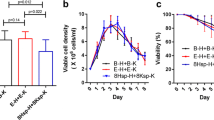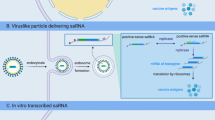Abstract
Shiga toxin B-subunit (STxB) from Shigella dysenteriae targets in vivo antigen to cancer cells, dendritic cells (DC) and B cells, which preferentially express the globotriaosylceramide (Gb3) receptor. This pivotal role has encouraged scientists to investigate fusing STxB with other clinical antigens. Due to the challenges of obtaining a functional soluble form of the recombinant STxB, such as formation of inclusion bodies during protein expression, scientists tend to combine STxB with vaccine candidates rather than using their genetically fused forms. In this work, we fused HPV16 E7 as a vaccine candidate to the recombinantly-produced STxB. To minimize the formation of inclusion bodies, we investigated a number of conditions during the expression procedure. Then various strategies were used in order to obtain high yield of soluble recombinant protein from E. coli which included the use of different host strains, reduction of cultivation temperature, as well as using different concentrations of IPTG and different additives (Glycin, Triton X-100, ZnCl2). Our study demonstrated the importance of optimizing incubation parameters for recombinant protein expression in E. coli; also showed that the secretion production can be achieved over the course of a few hours when using additives such as glycine and Triton X-100. Interestingly, it was shown that when the culture mediums were supplemented by additives, there was an inverse ratio between time of induction (TOI) and the level of secreted protein at lower temperatures. This study determines the optimal conditions for high yield soluble E7-STxB expression and subsequently facilitates reaching a functionally soluble form of STxB-based vaccines, which can be considered as a potent vaccine candidate for cervical cancer.
Similar content being viewed by others
References
Baneyx F and Mujacic M. 2004. Recombinant protein folding and misfolding in Escherichia coli. Nat Biotechnol, 22: 1399–1408.
Buchner J, Pastan I and Brinkmann U. 1992. A method for increasing the yield of properly folded recombinant fusion proteins: single-chain immunotoxins from renaturation of bacterial inclusion bodies. Anal Biochem, 205: 263–270.
Choi J H and Lee S Y. 2004. Secretory and extracellular production of recombinant proteins using Escherichia coli. Appl Microbiol Biotechnol, 64: 625–635.
Choi N W, Estes M K and Langridge W H R. 2005. Oral immunization with a shiga toxin B subunit: Rotavirus NSP4(90) fusion protein protects mice against gastroenteritis. Vaccine, 23: 5168–5176.
Goncalves A N, Meschiari C A, Stetler-Stevenson W G, Nonato M C, Alves C P, Espreafico E M and Gerlach R F. 2012. Expression of soluble and functional full-length human Matrix Metalloproteinase-2 in Escherichia coli. J Biotechnol 157: 20–24.
Haicheur N, Bismuth E, Bosset S, Adotevi O, Warnier G, Lacabanne V, Regnault A, Desaymard C, Amigorena S and Ricciardi-Castagnoli P. 2000. The B subunit of Shiga toxin fused to a tumor antigen elicits CTL and targets dendritic cells to allow MHC class I-restricted presentation of peptides derived from exogenous antigens. J Immunol, 165: 3301–3309.
Haicheur N, Benchetrit F, Amessou M, Leclerc C, Falguires T, Fayolle C, Bismuth E, Fridman W H, Johannes L and Tartour E. 2003. The B subunit of Shiga toxin coupled to full-size antigenic protein elicits humoral and cell-mediated immune responses associated with a Th1 dominant polarization. Int immunol, 15: 1161–1171.
Han L, Doverskog M, Enfors S O and Häggström L. 2002. Effect of glycine on the cell yield and growth rate of Escherichia coli : evidence for cell-density-dependent glycine degradation as determined by 13C NMR spectroscopy. J Biotechnol, 92: 237–249.
Humphreys D P, Sehdev M, Chapman A P, Ganesh R, Smith B J, King L M, Glover D J, Reeks D G and Stephens P E. 2000. High-level periplasmic expression in Escherichia coli using a eukaryotic signal peptide: importance of codon usage at the 5′end of the coding sequence. Protein Expr Purif, 20: 252–264.
Janssen K P, Vignjevic D, Boisgard R, Falguires T, Bousquet G, Decaudin D, Dolli F, Louvard D, Tavitian B and Robine S. 2006. In vivo tumor targeting using a novel intestinal pathogen-based delivery approach. Cancer Res, 66: 7230–7237.
LaCasse E C, Saleh M T, Patterson B, Minden M D and Gariepy J. 1996. Shiga-like toxin purges human lymphoma from bone marrow of severe combined immunodeficient mice. Blood, 88: 1561–1567.
Lee R S, Tartour E, Van der Bruggen P, Vantomme V, Joyeux I, Goud B, Fridman W H and Johannes L. 1998. Major histocompatibility complex class I presentation of exogenous soluble tumor antigen fused to the B-fragment of Shiga toxin. Eur J Immunol, 28: 2726–2737.
Li J, Liu J, Lan X, Cheng J, Wu R, Lou Z Z, Yin X, Li X, Li B and Yang B. 2009. Cloning the structure genes and expression the N gene of porcine epidemic diarrhea virus DX. Virol Sin, 24: 179–186.
Li Y L, Liu J, Liu J N and Zhang J. 2011. Immunization of protein HPV16 E7 in fusion with mouse HSP70 inhibits the growth of TC-1 cells in tumor bearing mice. Vaccine, 29: 5959–5962.
Nakagawa I, Nakata M, Kawabata S and Hamada S. 1999. Regulated expression of the Shiga toxin B gene induces apoptosis in mammalian fibroblastic cells. Mol Microbiol, 33: 1190–1199.
Ni Y and Chen R. 2009. Extracellular recombinant protein production from Escherichia coli. Biotechnol Lett, 31: 1661–1670.
O’Brien A D, Tesh V L, Donohue-Rolfe A, Jackson M P, Olsnes S, Sandvig K, Lindberg A A and Keusch G T. 1992. Shiga toxin: biochemistry, genetics, mode of action and role in pathogenesis. Curr Top Microbiol Immunol, 180: 65–94.
Ohmura M, Yamamoto M, Tomiyama-Miyaji C, Yuki Y, Takeda Y and Kiyono H. 2005. Nontoxic Shiga toxin derivatives from Escherichia coli possess adjuvant activity for the augmentation of antigen-specific immune responses via dendritic cell activation. Infect Immu, 73: 4088–4097.
Sadraeian M, Honari H, Madanchi H and Hesaraki M. 2011. Cloning and Expression of CtxB-StxB in Esherichia coli : A challenge for Improvement of Immune Response Against StxB. Iran J Pharm Sci, 7: 185–190.
Sedighzadeh S S, Shamsara M and Shahpiri A. 2012. Fusion Protein Strategy to Increase Expression and Solubility of Hypervariable Region of VP2 Protein of Infectious Bursal Disease Virus in Escherichia coli. Prot J: 1–5.
Shaw C A and Starnbach M N. 2003. Using modified bacterial toxins to deliver vaccine antigens. ASM News, 69: 384–389.
Vingert B, Adotevi O, Patin D, Jung S, Shrikant P, Freyburger L, Eppolito C, Sapoznikov A, Amessou M and Quintin-Colonna F. 2006. The Shiga toxin B-subunit targets antigen in vivo to dendritic cells and elicits anti-tumor immunity. Eur J Immunol, 36: 1124–1135.
Wang P, Song P, Li X, Su R R, Wang H and Zhu G P. 2012. Study on soluble expression of glutamate dehydrogenase from tea plant in Escherichia coli using fusion tags. African J Biotechnol, 11: 6241–6250.
Weikert C, Sauer U and Bailey J E. 1998. An Escherichia coli host strain useful for efficient overproduction of secreted recombinant protein. Biotechnol Bioeng 59: 386–391.
Yang J, Moyana T, MacKenzie S, Xia Q and Xiang J. 1998. One Hundred Seventy-Fold Increase in Excretion of an FV Fragment-Tumor Necrosis Factor Alpha Fusion Protein (sFV/TNF-α) from Escherichia coli Caused by the Synergistic Effects of Glycine and Triton X-100. Appl Environ Microbiol, 64: 2869–2874.
Zhang S, Fan R, Yang T, Sun Y, Li J, Xu Q and Zhou P. 2009. An improved strategy for efficient expression and purification of soluble HIV-1 tat protein in E. coli. Virol Sin, 24: 518–528.
Author information
Authors and Affiliations
Corresponding author
Additional information
Foundation item: This work was supported by Research Council of Shiraz University of Medical Sciences (91-01-36-4417), Shiraz, Iran.
Rights and permissions
About this article
Cite this article
Sadraeian, M., Ghoshoon, M.B., Mohkam, M. et al. Modification in media composition to obtain secretory production of STxB-based vaccines using Escherichia coli . Virol. Sin. 28, 43–48 (2013). https://doi.org/10.1007/s12250-013-3286-9
Received:
Accepted:
Published:
Issue Date:
DOI: https://doi.org/10.1007/s12250-013-3286-9




